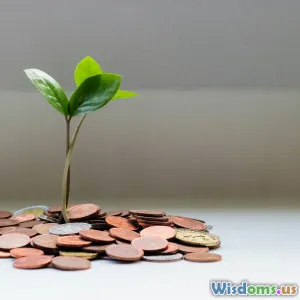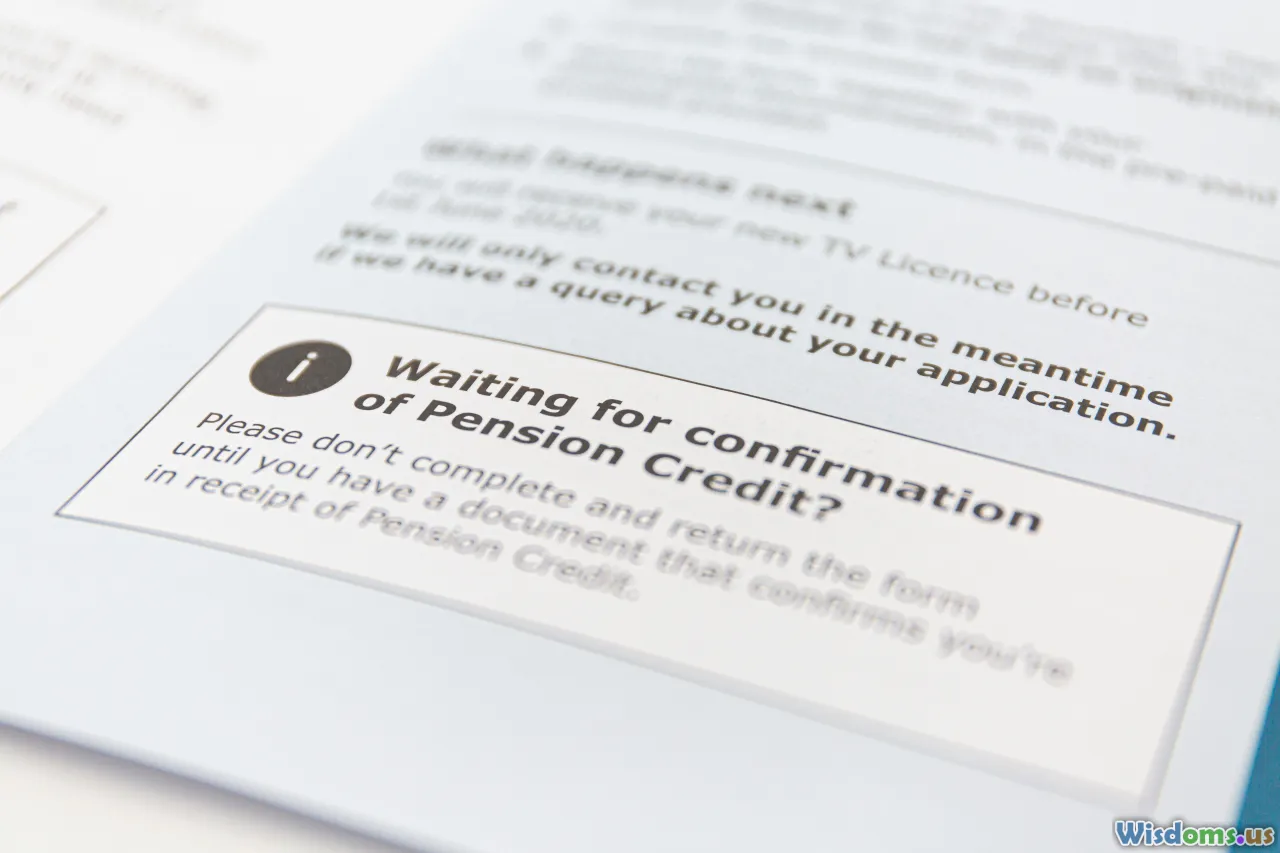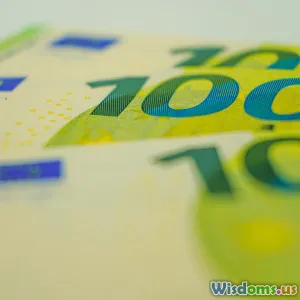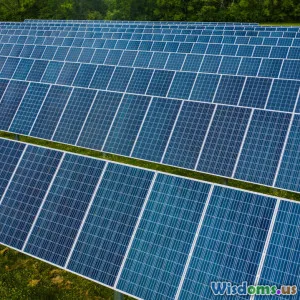
Step by Step Guide to Launching a Green Investment Portfolio
20 min read Learn how to launch a green investment portfolio with actionable steps for eco-conscious investors. (0 Reviews)
Step by Step Guide to Launching a Green Investment Portfolio
Building wealth and sustaining the planet are no longer mutually exclusive goals. Savvy investors increasingly recognize the financial and ethical rewards of sustainable investing. Green investment portfolios—carefully curated investments aligned with environmental, social, and governance (ESG) priorities—offer a practical route for those looking to grow their assets while supporting a greener, more responsible economy. If you’re ready to integrate sustainability into your investment strategy, this guide walks you through the entire process of launching a green investment portfolio, from inception to ongoing management, highlighting best practices, tools, and essential examples along the way.
Clarifying Green Investing: What It Entails

Before making your first green investment, it’s critical to understand what qualifies as ‘green’, and how this approach differs from traditional investing.
Green investing refers to allocating capital toward companies, projects, or funds that contribute to environmental sustainability. These can range from renewable energy projects and green bonds to companies excelling in waste reduction or climate innovation. ESG investing, while broader, encompasses environmental (E), social (S), and governance (G) considerations and often overlaps with green investment portfolios when the focus is on environmental impact.
A classic example: Tesla, often considered a flagship for environmental innovation, is a common holding in many green funds due to its commitment to electric mobility. However, genuinely green portfolios span much further—including firms in wind energy (Vestas), solar panel technology (First Solar), sustainable agriculture (Beyond Meat), and even water infrastructure (Xylem Inc.).
The green investment universe offers incredible breadth, encompassing:
- Renewable energy (e.g., solar, wind, hydro)
- Energy efficiency (smart grids, insulation solutions)
- Sustainable transport (electric vehicles, bicycles)
- Environmental technologies (water purification, recycling)
Understanding this landscape is essential—for both targeting authentic impact and for success in portfolio construction.
Assessing Your Investment Goals and Values

Every solid investment journey starts with deeply personal foundations. Why do you want to pursue green investing? The answer shapes your decisions at every step.
Ask yourself:
- Are you motivated primarily by climate action, risk mitigation, long-term growth, or all the above?
- Is your risk tolerance low (preserving capital), moderate (moderate growth), or high (pursuing breakthrough innovations)?
- What time horizon suits your goals—short (1–3 years), medium (3–7 years), or long term (7+ years)?
Example: Consider two investors:
- Marie wants to climate-proof her retirement fund and preserve wealth, leaning toward green bonds and well-established ESG mutual funds.
- Omar is eager to support startups disrupting clean energy tech for potentially high returns (and higher risk) in early-stage equities.
Define your priorities and remember, no single green investing strategy is universally optimal. The right fit tailors both your financial and environmental aspirations.
Researching Green Investment Options

The landscape of green investing is rich, and with growth comes complexity. Doing your homework on the available options is essential to avoid greenwashing and maximize genuine impact.
1. Public Equities: Stocks and Funds
- Individual Stocks: Invest directly in companies leading on sustainability, like NextEra Energy (renewable utility), Orsted (offshore wind), and Enphase Energy (solar microinverters).
- Mutual Funds & ETFs: Hundreds of funds now screen firms based on ESG or dedicated environmental criteria. Examples include the iShares Global Clean Energy ETF (ICLN) and the Green Century Equity Fund (GCEQX).
2. Fixed Income: Green Bonds and ESG Bonds
- Green Bonds: Issued by governments or corporations to finance climate-friendly projects. The World Bank’s green bonds helped build wind farms in Turkey and safe water systems in Indonesia.
3. Alternative Investments
- Private Equity/Venture Capital: Accessed by high-net-worth or accredited investors, these often back breakthrough startups in sustainable technology.
- REITs (Real Estate Investment Trusts): Certain REITs focus exclusively on energy-efficient buildings or green infrastructure.
4. Thematic and Impact Investing
- Platforms: Crowd-investing tools like Raise Green or crowdfunding for solar arrays (through platforms like Mosaic) let smaller investors take part in large projects.
Pro Tip: Use databases like Morningstar Sustainability Ratings or the US SIF List of Mutual Funds to compare fund options, sustainability metrics, and historical performance.
Detecting and Avoiding Greenwashing

Unfortunately, as the popularity of sustainable investing surges, so does greenwashing—the misleading marketing of investments as ‘eco-friendly’ without substantiated environmental benefit.
How do you separate genuine green investments from hollow claims?
- Scrutinize Third-Party Ratings: Seek out portfolios and funds certified by groups such as MSCI ESG Ratings, Sustainalytics, or the PRI (Principles for Responsible Investment).
- Analyze Holding Reports: Review underlying assets. Research fund top holdings and assess whether these companies have credible, science-based targets and sustainability reporting. For example, scrutinize fossil-fuel exclusions or how net zero targets are tracked.
- Read the Prospectus and Methodology: Corresponding documents must outline ESG screens or impact metrics. If an ETF claims to be clean energy-focused, investigate whether its companies derive a significant portion of revenue from renewables.
Red Flags:
- Vague, jargon-filled marketing materials.
- Significant exposure to companies embroiled in environmental controversies.
- Lack of transparent, up-to-date reporting.
A 2022 study by the European Securities and Markets Authority found over 42% of "ESG" funds exhibited poor environmental alignment upon granular analysis—so diligence pays.
Choosing Your Account Type and Platform

Setting up the right account forms the bridge between intention and investment. Today’s diverse platforms cater to everyone from beginner to expert.
Key Account Types
- Brokerage Account: For stocks, ETFs, and bonds.
- IRA or Roth IRA: For individuals looking to add sustainable funds to retirement savings.
- Employer 401(k): Many now provide ESG or green mutual fund options.
Selecting a Platform
Modern brokerage platforms, like Charles Schwab, Fidelity, or E*TRADE, provide access to hundreds of ESG funds. For fully digital, impact-driven options, consider:
- Swell (formerly): Dedicated ESG investing, though not operational as of 2024.
- Betterment & Wealthfront: Robo-advisors now enable customizable ESG portfolios.
- Aspiration: Focuses on fossil fuel-free portfolios and carbon offset add-ons.
Look for platforms providing robust ESG data, impact reporting tools, customizable screens, and low minimum investment thresholds.
Tip: Always factor fees and commissions. While the average ETF fee is below 0.25%, green or ESG funds may levy slightly higher costs—a tradeoff you must weigh against transparency and alignment.
Building and Diversifying Your Green Portfolio

Once you have access to your chosen investment accounts, it’s time to construct your portfolio. A well-designed portfolio balances your environmental ambition with risk and returns—just like a traditional finance-first setup.
1. Determine Your Asset Allocation
A common starting point is the 60/40 split: 60% equities, 40% fixed income. In green investing, you might split:
- 50% green/ESG equity funds or stocks
- 30% green bonds or related ETFs
- 10% real estate via green REITs
- 10% thematic impact investments (e.g., climate project crowd-funding)
Tailor the split based on your risk appetite—higher equity for aggressive investors, more bonds for the conservative.
2. Diversify Across Sectors and Geographies
- For example, hold stakes across solar, wind, water solutions, electric transport, and sustainable agriculture.
- Invest in both developed and emerging markets. While Orsted is a Danish wind giant, PowerGrid is electrifying India’s grid with renewables.
3. Example Portfolio
Let’s build a $10,000 starter portfolio:
| Asset | Allocation | Exemplary Holding |
|---|---|---|
| Global Clean Energy ETF | 30% | ICLN |
| Green Bond Fund | 20% | iShares Green Bond ETF (BGRN) |
| Water Infrastructure Company | 15% | Xylem Inc (XYL) |
| Agro-Tech Stock | 10% | Beyond Meat (BYND) |
| Green REIT | 15% | Hannon Armstrong (HASI) |
| Climate Crowd-Investing | 10% | Mosaic Platform |
Remember: Periodically rebalance to maintain your desired allocation, especially after market shifts or as new green opportunities emerge.
Evaluating Performance: Returns and Impact

Unlike pure financial portfolios, green portfolios offer a dual return: financial growth and positive impact. Measuring both is essential for success (and satisfaction).
1. Tracking Financial Performance
Utilize digital portfolio dashboards or tools such as Morningstar and Personal Capital. Compare your returns to conventional benchmarks like the S&P 500—a recent MSCI report noted that many ESG indices performed on par or above mainstream counterparts between 2019–2023.
2. Assessing Environmental and Social Impact
Impact is trickier to measure but increasingly transparent. Many funds provide annual sustainability or impact reports, detailing anecdotes and statistics such as:
- CO2 emissions avoided
- Renewable megawatts generated
- Water saved or recycled products produced
3. Tools and Certifications
Look for investments aligned with initiatives such as:
- The UN SDGs (Sustainable Development Goals)
- Science Based Targets initiative (SBTi)
- B Corps certification
Example: Affirmative Investing—where a fund directly invests in solutions (like Tesla’s Gigafactory, or Vestas’ new wind farm)—can result in more visible, reportable impact vs. exclusionary investing (simply avoiding polluters).
Staying Informed: Navigating a Dynamic Landscape

Sustainable investing is rapidly evolving. New rules, tech innovations, and societal shifts redefine what it means to be ‘green’ every year. Stay ahead with ongoing research and education.
- Regulatory Trends: In 2023, the U.S. SEC passed new disclosure requirements mandating that funds clarify ESG distinctions—helping sharp investors sidestep greenwashing.
- New Investment Products: Funds like Engine No. 1 Transform ETF (VOTE) give shareholders power to influence corporate climate agendas. Also, ‘transition bonds’ and thematic indices make it easier than ever to customize your impact.
- Education & News: Subscribe to outlets like GreenBiz, The Forum for Sustainable and Responsible Investment (US SIF), or the Financial Times Sustainable Investing newsletter for breaking insights.
Tip: Join communities or attend webinars (many free!) to exchange ideas, learn from veteran ESG investors, and stay inspired.
Ethical Challenges: Navigating Complex Choices

Even green investors confront complicated realities. Sometimes, the path isn't black-and-white.
Consider:
- Should you support legacy energy firms actively investing in renewables but still profiting from fossils (such as Shell or BP)?
- How much weight do you give to corporate lobbying policies or outsourced labor practices?
Solution: Decide your personal “red lines” and document your core values. Periodically review and adjust. Even the best-intentioned portfolios sometimes require trade-offs—transparency and continuous learning go a long way.
In Practice: Some investors choose not to automatically exclude conglomerates with cross-sector exposure (i.e., General Electric) if their breakthrough green tech divisions outweigh their environmental harm elsewhere—a calculated risk often supported by third-party research.
Making Your First Investment: Step-by-Step Example

Ready to take the leap? Let’s walk through a typical first purchase for a green portfolio.
- Log in to Your Brokerage Account.
- Search for Your Chosen Green Fund or Stock. E.g., enter “ICLN” for iShares Global Clean Energy ETF.
- Read the Fund Overview and ESG Metrics. Confirm alignment with your criteria (look for top holdings, impact summary, and screening methodology).
- Enter Amount and Place Order. Decide whether to invest a flat sum or implement dollar-cost averaging (regular, scheduled buys to smooth out market volatility).
- Confirm Transaction and Document Investment. Note down your rationale to maintain focus on long-term goals, rather than knee-jerk market reactions.
Some robo-advisors (like Betterment) will auto-invest your deposit according to your selected sustainability screens—making first steps even easier.
Pro Tip: Don’t wait for “perfection.” Launch with what you know, then iterate as your understanding and resources grow.
Monitoring and Adjusting Your Portfolio

A successful green portfolio needs ongoing attention. Just as businesses continuously evolve, so do regulatory standards, industry leaders, and global needs.
Periodic Review Checklist:
- Quarterly Check-ins: Evaluate both performance and impact reports.
- Annual Rebalancing: Adjust your allocations as assets grow at uneven rates.
- Keeping Up With New Offerings: Replace underperformers or funds that drift from sustainability targets.
- Tax-Loss Harvesting: Offset gains by selling underperforming assets—a tax strategy useful for both the planet and your portfolio.
Remember, your portfolio is ultimately a reflection of your values and your vision for future financial resilience.
Launching a green investment portfolio is a meaningful journey—one that combines informed analysis, values-driven decision-making, and ongoing stewardship. As you embark on this path, know that each dollar you invest makes both a statement and a tangible difference. With your financial future riding alongside a push toward a more sustainable, equitable world, you’re part of a movement that’s reshaping the very purpose of investing. Green investing is not just an opportunity; it’s a responsibility and a privilege. Make the most of it.
Rate the Post
User Reviews
Popular Posts


















